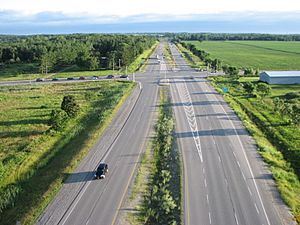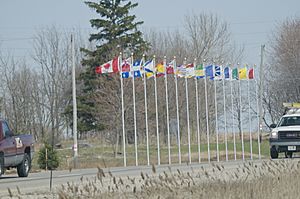Veterans Memorial Parkway facts for kids
Quick facts for kids
Veterans Memorial Parkway |
|||||||
|---|---|---|---|---|---|---|---|
| Formerly Airport Road Formerly Highway 100 |
|||||||
| Lua error in Module:Infobox_road/map at line 15: attempt to index field 'wikibase' (a nil value). | |||||||
| Route information | |||||||
| Maintained by City of London | |||||||
| Length | 13.4 km (8.3 mi) | ||||||
| History | Opened in 1977 as a two-lane expressway Widened in 2006 to a modern, at-grade expressway | ||||||
| Major junctions | |||||||
| South end | Wilton Grove Road | ||||||
| North end | Clarke Road | ||||||
| Location | |||||||
| Major cities: | London | ||||||
| Highway system | |||||||
Roads in Ontario
|
|||||||
The Veterans Memorial Parkway (VMP) is a major road in London, Ontario. People who live nearby often just call it "Veterans." It's a special type of road called an expressway. This means it's designed for faster travel with fewer stops.
The VMP is about 13.4 kilometers (8.3 miles) long. It stretches through the eastern part of London. In the past, this road had different names. From 1977 to 1994, it was known as King's Highway 100. Then, until 2006, it was called Airport Road. Today, it's a four-lane road with traffic lights at some intersections. There are plans to make it even better in the future. This includes adding more lanes and special ramps (called interchanges) to help traffic flow smoothly.
Contents
How the Parkway Was Built
For many years, leaders in London talked about building better roads. They wanted a fast road that would connect to other major highways like Highway 401 and Highway 402. However, they couldn't agree on where to build it. Some plans would have cut through neighborhoods.
Finally, the government of Ontario and the City of London came up with a plan. They decided to build a new road along the eastern side of London. This road would be a compromise. It would help traffic but wouldn't cause too much disruption.
Building the First Sections
Construction on this new road began in 1975. It was designed as a two-lane highway at first. But it had plenty of space (a right-of-way) for more lanes to be added later. This was a smart idea for the future.
The road was officially opened in 1977. It was named Airport Road because it led towards the London International Airport. It also had the highway number Highway 100. It had traffic lights at intersections, but the design allowed for future interchanges (ramps) to be built if needed.
Changes Over Time
In 1994, the province handed over control of the highway to the City of London. This meant the city became responsible for its upkeep.
Later, in 1997, the road was made longer. It was extended further north from Oxford Street to Huron Street.
A big improvement happened in 2004. The City of London started to make Airport Road wider. They used the extra space that was planned years ago. They added another set of lanes, separated by a grassy area. This made it a four-lane, divided highway. This project was finished in late 2005.
A New Name for Heroes
In September 2006, the road got its current name: Veterans Memorial Parkway. This name was chosen to honor Canadian veterans. These are brave men and women who served in wars like World War I, World War II, and the Korean War.
In 2010, the Parkway got even more special touches. A large monument was put up near the Highway 401 entrance. Trees were planted along the road, and flagpoles were raised. These additions help remind everyone of the veterans the road honors.
Recent Upgrades
More construction took place in 2016. The southern end of the Parkway was extended to Wilton Grove Road. Also, the way the Parkway connects with Highway 401 was improved. It became a 4-way interchange, which makes it easier for cars to get on and off. This project was completed in November 2017.
In 2020, the Parkway was extended even further north and west. It now reaches Clarke Road. This extension opened in the fall of 2020.
Future Plans for the Parkway
The Veterans Memorial Parkway is an important part of London's transportation plans. The city has big ideas for its future.
Connecting London's Roads
For a long time, London has thought about having a "ring road." This is a road that goes around the city, helping traffic move faster. The Veterans Memorial Parkway is planned to be the eastern part of this future ring road.
There are also talks about extending the Parkway south of Highway 401. This would connect it to Highway 3 in St. Thomas. The city also wants to make the road wider between Oxford Street and Huron Street.
Planned Interchanges
The City of London has studied the entire Parkway to see where new interchanges can be built. An interchange is a system of ramps that allows cars to switch roads without stopping at a traffic light. This would turn the Parkway into a freeway, which is a road with no traffic lights at all.
Here are some of the places where new interchanges are planned: The City of London has assessed the entire length of the Veterans Memorial Parkway, identifying areas where interchanges can be constructed, grade separations can occur, and cul-de-sacs (replacing previously at-grade intersections for minor surface roads) can be placed. These changes would upgrade the Veterans Memorial Parkway from a partial control-access expressway to a fully controlled-access freeway for the majority of its length.
| km | mi | Destinations | Notes | |
|---|---|---|---|---|
| 0 | 0.0 | Wilton Grove Road (at-grade intersection) | Construction began in September 2016 and finished in November 2017 | |
| 1 | 0.62 | This was improved in 2017 to a 4-way interchange. | ||
| 2 | 1.2 | Bradley Avenue (at-grade intersection) | An overpass (bridge) is planned here. | |
| 4 | 2.5 | Hamilton Road (at-grade intersection) | A Parclo A-4 interchange is planned. | |
| 5 | 3.1 | River Road (at-grade intersection) | An overpass is planned. | |
| 6 | 3.7 | Gore Road (at-grade intersection) | A Diamond interchange is proposed. | |
| 7 | 4.3 | Tartan Drive (at-grade intersection) | Plans include creating cul-de-sacs (dead-end streets) here. | |
| 7 | 4.3 | Trafalgar Street (at-grade intersection) | A Diamond interchange is proposed. | |
| 8 | 5.0 | Admiral Drive (at-grade intersection) | Plans include creating cul-de-sacs here. | |
| 8 | 5.0 | Dundas Street (at-grade intersection) | A Diamond interchange is proposed. | |
| 9 | 5.6 | Page Street (at-grade intersection) | Plans include creating cul-de-sacs here. | |
| 9 | 5.6 | A Diamond interchange is proposed. This road also leads to the London International Airport. | ||
| 10 | 6.2 | Huron Street (at-grade intersection) | A Diamond interchange is proposed. | |
| 11 | 6.8 | Clarke Road (at-grade intersection) | The extension to Clarke Road opened in Fall 2020. The Parkway ends here and continues as Clarke Road. | |
| 1.000 mi = 1.609 km; 1.000 km = 0.621 mi | ||||




